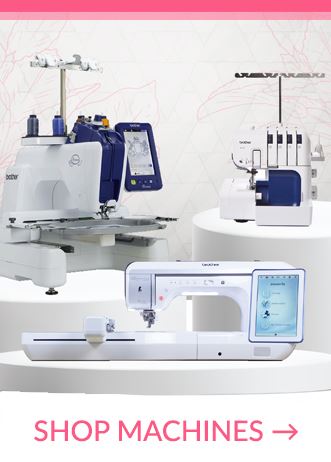Machine maintenance—thread problems
Here we have a list of common thread problems that may affect the performance of your embroidery machine.
Back spin
Sometimes the thread spool will spin back on itself causing the thread or twist around the bottom of the spool pin. This is often caused because the little circle of felt that sits under the spool pin has been lost. Replace the felt to help prevent back spin.
Bobbins and bobbin case
- Check you are using the correct bobbin case and bobbins for your machine model. If you are unsure refer to your manual or visit your local machine retailer.
- Check for bent of damaged bobbins. Run your fingers over them occasionally to see if the needle has been hitting and leaving tiny indentations as this could also indicate that the needle height needs adjusting.
- Check for tiny rust spots especially if you live near the ocean as salt air can get into the most unexpected places.
Bobbin winder
If the thread is not wound onto the bobbin properly you may experience problems with your thread. Check the bobbin winder is working correctly, using the correct tension to wind the spool and is not overfilling the bobbin. The bobbin should slip into the bobbin case easily without any force and have an evenly distributed wind.
Cleaning
An embroidery machine runs at a very high speed and fibre particles accumulate quickly as the thread passes through the bobbin area and the tensions discs. Regularly run a piece of crisp paper between the tension discs and clean the inside of the bobbin case as well as the shuttle area often to clear away caught fibres and lint. While cleaning, check for any roughness or burrs on the hook.
Thread guides
Check the thread guides on your machine for damage, they should feel smooth, have no rough areas or be bent.
Threading the machine
Straight-wound and cross-wound thread
How the thread has been wound onto the spool is also of importance. I have been taught to place thread onto the spool pin with the writing facing upwards, I am sure that this is correct but it does have logic. Generally, a straight-wound spool runs better from the side and a cone (usually cross-wound) runs better from the top. With the variations of machines today and different positions of the spool pins (some vertical, some horizontal) if you are having problems with the thread feed, try changing the position of the spool or turn the thread over. A thread stand can help prevent the thread from twisting as it runs from the spool to the machine thread guides.
Thread tension for embroidery
If the thread tensions on your machine are not self-adjusting for embroidery, use an uneven or unbalanced tension. Increase the bobbin tension and reduce the needle tension enough so that the bobbin thread does not show on the right side of your stitching and the needle thread turns under slightly on the wrong side of the fabric.
Tension disks
When you are threading the needle, it is important that the presser foot is in the raised position. The action of raising the presser foot lifter (also called take-up lever) releases the tension discs and the thread will slip between the discs easily. While you are sewing on your machine the presser foot is in the lowered position and the upper thread tension discs are pressed closely together. By not raising the presser foot the thread cannot slip between the discs and there will be no tension on the thread.
Needle/thread/fabric relationship
Incorrect needle size or burred and blunt needles will cause embroidery thread to break, shred and split. Change the needle often and use the correct size and type for the fabric and thread in use.
Bobbin
Yes we have all been guilty at one time or another of winding one coloured thread over the top of another. No excuses please, this is poor practice and will cause tension and thread problems. Tidy up and free up your spare bobbins now by discarding the old thread. Begin new embroidery project with a full, evenly wound bobbin.
Bobbin thread
Use a good quality thread in the bobbin. Special purpose bobbin threads are available in black and white. These threads are strong but fine, which means more, can be wound onto the bobbin so the bobbin does not need to be filled as often. Designed for high-speed sewing and to add less bulk to the embroidery design, the result achieve a softer more flexible finish and they are economical to use.




